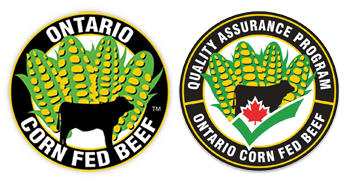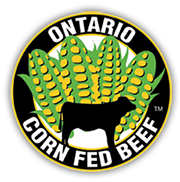In order to measure the impact the Ontario Corn Fed Beef program has had on Ontario cattle prices in Ontario, independent reviews have been performed by leading Ontario agriculture analyst organizations.
In May 2014 the George Morris Centre released it’s report titled “Cattle Pricing Impact of Ontario Corn Fed Beef Program”
A summary of the key findings include:
- The Ontario Corn-Fed Beef (OCFB) program was launched in June of 2001 to expand the market for and profile of Ontario-produced beef.
- Ontario Corn-fed beef seeks to provide consumers with a recognizable brand and logo that assures them of receiving a product consistently produced in accordance with established quality standards.
- The program is now being viewed as an example of a successful branding and differentiation program.
- The OCFB production and marketing methods are being held as examples for other regions or commodities to follow across Canada.
- Ontario Corn Fed Beef is now an effective branded product. As such it is not readily interchangeable with imported competing beef
- The OCFB program has a positive impact on demand and it effectively commits or removes a significant component of supply.
- Based on simple analysis of price flexibility it can be logically asserted that the Ontario Corn Fed Beef program is generating up to $2/cwt or about $26/head in added revenue to Ontario cattle producers
In October 2018 a second report was provided by Kevin Grier Market Analysts titled, Ontario Corn Fed Beef Ontario Corn Fed Beef Program Evaluation
A summary of the key findings include:
- All program participants from cattle feeder through retail and restaurant participate in order to produce and/or market a differentiated product.
- Participants assert that the Corn Fed product provides them with a strategic differentiator that is actually recognizably different in terms of product quality. Differentiation is the central driver of the brand value.
- Another differentiating point is the geographic fact that it is marketed as an Ontario product building on the local food movement.
- The inability to substitute non-Corn Fed is the most significant factor in assessing the program’s value contribution. It has leverage because it has differentiated itself in the market.
- Logic and evidence point to the program as a major contributor to the positive trends in the Ontario industry.
- The program has achieved its quality goals and is contributing to increasing the competitiveness of the Ontario industry.
- OCFB has given Ontario packers a program that differentiates them from their competitors in the west and the U.S. This is an important factor in driving demand for fed Ontario cattle.
- Based on price flexibility analysis it can be calculated that the basis or local price spread in Ontario is stronger by about $2-3/cwt or about $25-30/head due to the Corn Fed program.
- It is important to note that the $2-3/cwt in added value is applied to all cattle marketed in Ontario, not just the Corn Fed program cattle.
- The added value is passed through the chain. In a competitive market such as cattle the added value at the cattle feeder level is passed along to the cow-calf sector. That is ultimately the positive pricing impact of the program at $2-3/cwt is passed to the cow-calf sector.
- The Corn Fed program adds value through the entire Ontario beef and cattle supply chain from retail through to cow-calf farmer.

